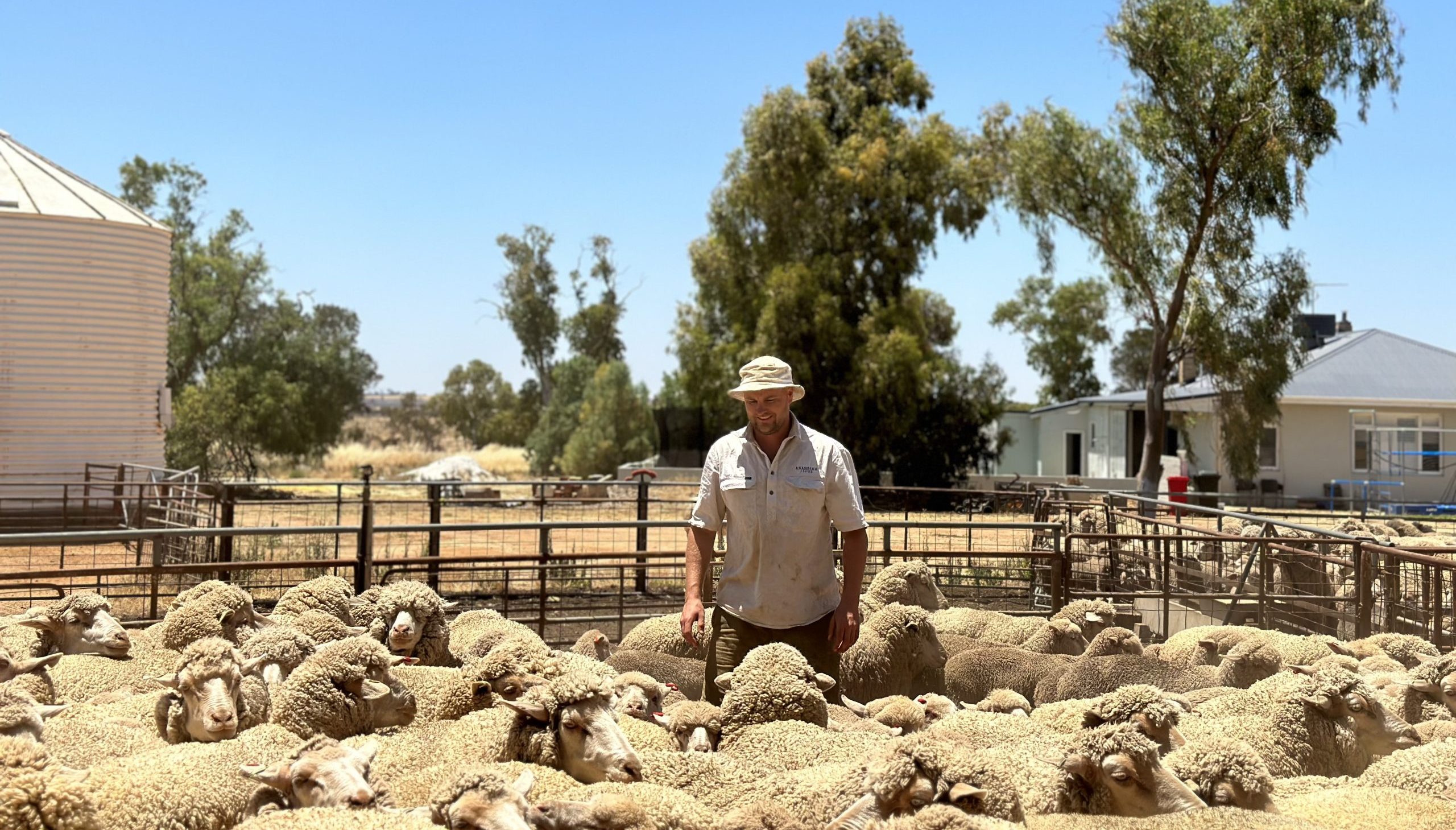
Oscar York with some of the Anameka Farms Merino flock. Photo: Anameka Farms
WESTERN Australia’s York family at Tammin is planning to rebuild its sheep numbers next year in order to ensure risk is spread in what looks like being another year of high input costs for cropping, and in the face of ongoing issues with herbicide resistance.
Oscar York, who is part of the Anameka Farms partnership with his father Tony and uncle Simon in Western Australia’s central wheatbelt, said the target is to rebuild to a 6000-7000 ewes in its self-replacing Merino flock.
“Our sheep numbers have been the same for a long time at 5000-6000 ewes, and in the past year and half, it got down to 4500,” Mr York said.
The flock reduction occurred to minimise pressure on lighter country, and to reduce the amount of supplementary feeding needed by the flock in dry periods.
“We had a few dry years, and that was adding to us having to feed them for two or three years in a row.”
An above-average number of ewes was also sold to capitalise on buoyant restocker demand in eastern Australia caused by its seasonal turnaround, with 2300 breeders sold between November 2019 and May 2020 for a top price of $300.
Between November 2020 and May 2021, a further 2000 ewes were sold to a top of $225.
In both sale periods, November sales were dry ewes and April-May sales were mated ewes.
That eastern restocker market has since flattened, and the historically high cost of putting in a cash crop is adding to the appeal of rebuilding the flock.
“Next year we’ll try and get our numbers up.”
“We’re definitely looking at input costs for cropping next year; that would be the main reason, as well as risk management.”
The Yorks typically crop 11,000-12,000 hectares, and have 3000-4000ha of pasture.
Their 2022 winter crop covers 11,500ha, and they currently have 3500ha under pasture, with plans to put an additional 1000ha of cropping area into pasture to accommodate the larger flock.
About 1500ha of pasture is established biserrula, a significant fixer of nitrogen as well as a preferred source of feed.
Biserrula normally accounts for about one third of pasture, with the balance being unimproved pasture.
Sold to Victoria, NSW
The Yorks lamb in winter, and sell wether lambs at around 35-40 kilograms liveweight after keeping them for six months and finishing them on lupin and pea stubble before sale in January-February.
“We’re still fond users of the live sheep export trade, with our wether lambs going on the boats each year.”
While Anameka Farms’ cull maiden ewes generally go to WA restockers, surplus ewes from the past two years sold on AuctionsPlus as well as via agents as a means of getting them into a national market.
“That was a first for us.”
Anameka Farms employs a full-time livestock manager, and its Merino flock is built on AMS bloodlines.
Mr York said ewes sold last year were retained for an additional period, and sold mated.
Ewes sold between November 2019 and May 2021 sold to New South Wales and Victorian buyers.
“Since then, we haven’t had any to sell, as we want to rebuild our ewe flock up to 6000-7000.”
Stubble managers minimise mice
Compared with continuous croppers, Mr York said mixed operations like theirs are in the minority in the district, which is nonetheless home to several sizeable flocks, and some studs.
Mr York said anecdotal evidence points to farms with sheep having less of a problem with mice than cropping-only operations.
“This and last year, there were high mice numbers around, and we’ve not been as badly affected as others.”
While the Yorks still bait for mice, indications are their program is not as intensive as those on farms without sheep to clean up after the headers have been through.
“That’s a discovery we’ve had in the last two years.”
Mr York said having pasture in the rotation is helpful in minimising the impact of herbicide resistance, with ryegrass followed by wild radish the weeds of greatest concern.
“In our area, it’s a constant battle against weed resistance.”
Worst-impacted areas of Anameka Farms are generally cut for hay to minimise the weed spread, but the pasture or broadleaf phase, and sheep, are the key.
“Keeping paddocks in rotation, and including sheep, are great for doing what they do.”
“The bigger thing is the rotation, and that includes a two-year break with pasture, legumes or canola.”
The farm’s typical rotation is wheat followed by barley, then lupins, peas or pasture.
They are this season growing 1100ha of canola, with the broadleaf an alternative crop to follow cereals.
Lupins and peas have been grown at Anameka Farms since at least the 1990s, and biserrula was added around 10 years ago.
Along with some round-bale hay produced on farm, Anameka Farms feeds out the majority of the lupins it produces to sheep, with around 500-600t retained each year.



HAVE YOUR SAY